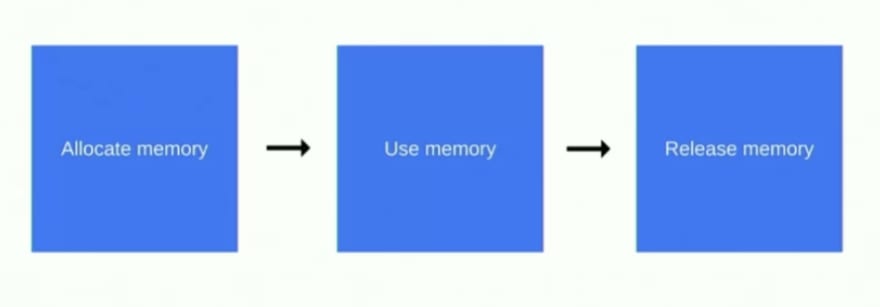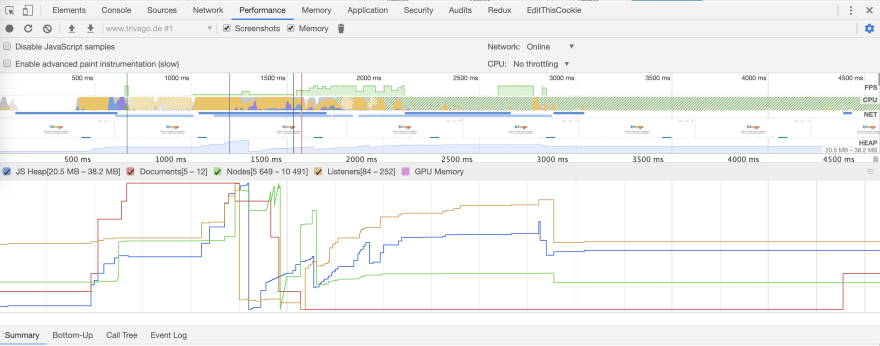The memory leaks are very hard to find in an application and they can be avoided during writing the code by taking some precautions. Every developer should be aware of the most common memory leak patterns.
In this article, I'll try to cover the memory lifecycle pattern in applications, the most common causes of memory leaks and how you can identify them in Chrome Dev Tools.
The Memory Lifecycle Patterns
The memory lifecycle pattern says that some memory is allocated to your code, The allocated memory is being used by your code and then it is released (freed) when your code is executed.
Causes of the Memory Leaks
1. The Accidental Global in non-strict mode
function iCauseMemoryLeak() {
temp = 1;
}
Here, you are assigning a value to temp variable which is not available in any of the scopes of the iCauseMemoryLeak function. The Javascript compiler sets the variable in the global scope and variable temp is not garbage collected in future. It stays there forever during your application lifecycle.
2. The Forgotten Timers
setTimeout(() => {
/** Perform a task here.. */
}, 1000);
// OR
setInterval(() => {
/** Perform a task here.. */
}, 1000);
The timers allocates dynamic memory to perform the task and if you forget to clear the timers, then it will cause a memory leak.
You can clear the setTimeout using clearTimeout and setInterval using clearInterval
var a = setTimeout(() => {
/** Perform a task here.. */
}, 1000);
clearTimeout(a);
// OR
var b = setInterval(() => {
/** Perform a task here.. */
}, 1000);
clearInterval(b);
3. The DOM manipulations
Just imagine, you have two buttons and when you click on buttonOne then it will remove the buttonTwo from the DOM.
const buttonOne = document.querySelector('#button-a');
const buttonTwo = document.querySelector('#button-b');
buttonOne.addEventListener('click', () => {
document.body.removeChild(buttonTwo);
});
In the above code, you remove the buttonTwo from DOM by clicking buttonOne, but we never remove the reference of buttonTwo which is stored in the variable buttonTwo. This kind of memory leak can be very dangerous.
We can avoid this by storing the reference of buttonTwo inside the click event listener.
const buttonOne = document.querySelector('#button-a');
buttonOne.addEventListener('click', () => {
const buttonTwo = document.querySelector('#button-b');
document.body.removeChild(buttonTwo);
});
Here, We remove the buttonTwo from the DOM by clicking on buttonOne and it is Garbage collected.
Identification in Chrome Dev Tools
- Open Chrome dev tools.
- Load your website.
- Select Memory checkbox in the performance panel and the click on Reload icon.
- Load the profile and memory graphs.
Analysing the Memory Graphs
What do you think? Which image does represent memory leak?
Let's find the answer by following the Memory Lifecycle Pattern.
Allocate memory, Use memory and Release memory.
In image A, The application starts, it uses some memory and then releases it and this nature follows until the application is in loading state. In the end, when the application is loaded, you can notice that the graphs stay almost linear and flat. It indicates that application with image A needs that reserved memory for the application run time and the required memory is constant.
While, on the other hand, In image B, The memory graphs are always increasing till the end, they are a step function and these graphs represent the increase in memory over time.
Now, we can say that image B represents the memory leak.
I hope you enjoy reading this article. Happy learning.
P.S. Can you guess the website in Image A of which I generated the memory graphs?










Oldest comments (5)
Thanks a bunch for this article. I like that the writing was fluent, straight to the point and the examples were practica. Learned a couple of new stuff.
Thanks for sharing!
Like your style of writing, direct attack on problem, how to identify and its resolution.
Hi @ayusharma_
Thank you for your article, quite insightful 👍
Also, from the screenshot on the Image A, it was trivago.de 😉😄
Would you consider doing a similar article but on the Memory pane, specially analyzing snapshots? That'd be very interesting 🤔
Nodes[55-266]
Sorry, Do you know what is unit of Nodes ? Does it represent node counts or memory size?